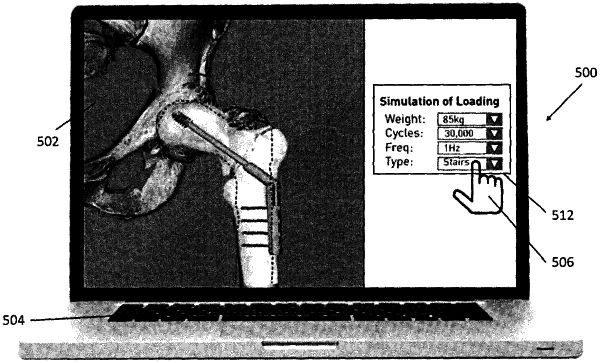| CPC A61F 2/30942 (2013.01) [G06F 30/20 (2020.01); G16H 10/60 (2018.01); G16H 30/40 (2018.01); G16H 50/70 (2018.01); A61F 2002/30948 (2013.01); A61F 2002/30952 (2013.01)] | 22 Claims |

|
1. A computer-implemented bone-implant system evaluation method for application of mesh-free analysis of trabecular bone of a bone-implant system, said method comprising:
(i) using a bone-implant model including a mesh-free trabecular bone model which comprises a plurality of bone data nodes which represents trabecular bone and comprises material properties of trabecular bone wherein bone data nodes of plurality of bone data nodes are free to interact with any neighboring bone data nodes of said plurality of bone data nodes upon contact with said neighboring bone data nodes and wherein said bone data nodes are broken off, moved, and redistributed from neighboring bone data nodes within the mesh-free trabecular bone model upon computer simulated loading of the bone-implant system, wherein the redistribution of bone data nodes is representative of fragmentation and redistribution of trabecular bone, for evaluation of performance of the bone-implant system for an implant implanted within the bone structure at an anatomical site;
(ii) receiving a set of bone structure data set, wherein set of bone structure data comprises data indicative of the bone structure wherein the bone structure comprises trabecular bone, at an anatomical site;
(iii) inputting an implant data set and inputting the position of the implant data set, wherein the implant is selected based upon the biomechanical requirements for the anatomical site and the position and of the implant data set is indicative of the position of the implant with respect to the anatomical site, wherein implant data set comprises data representative of the geometry and materials properties of the implant;
(iv) creating a bone-implant model, wherein said bone implant-model comprises a mesh-free trabecular bone model representative of said trabecular bone at the anatomical site wherein the bone-implant model is formed from the bone structure data set from step (ii), wherein said mesh-free trabecular bone model is an analytical model which comprises a plurality of bone data nodes which represents said trabecular bone at the anatomical site and which comprises material properties of said trabecular bone, wherein bone data nodes of said plurality of bone data nodes of said mesh-free trabecular model are free to interact with any neighboring bone data nodes of said plurality of bone data nodes upon contact with said neighboring bone data nodes, wherein said bone data nodes are broken off, moved, and redistributed from neighboring bone data nodes within the mesh-free trabecular bone model upon computer simulated loading of the bone-implant system, wherein the redistribution of bone data nodes is representative of fragmentation and redistribution of trabecular bone, and the implant data set from step (iii), and wherein the mesh-free model of trabecular bone is indicative of the trabecular bone structure of the bone structure at the anatomical site; and
(v) determining a biomechanical result based upon said computer simulated loading of the bone-implant system based upon mesh-free analysis of the bone-implant model by utilization of a mesh-free analytical method, wherein the biomechanical result comprises data based on the displacement of the implant relative to the bone of bone-implant model,
wherein steps (iii), (iv) and (v) are repeated automatically until a requisite implant data set is determined and a preferable implant positioning is obtained which provides said biomechanical requirements based on redefined parameters, and wherein upon the requisite implant data set being determined, an implant recommendation report is provided, wherein said implant recommendation report includes one or more of implant type, implant size, implant configuration, implant positioning, and combinations thereof.
|